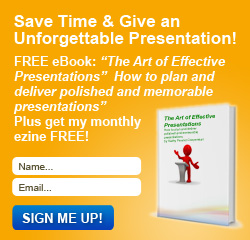First impressions are powerful. Likewise, the last few moments of a presentation leave a lasting impression. Get off to a great start by beginning with a well-rehearsed opening. This will boost your confidence and give you added energy to move into the body of your presentation.
Rather than abruptly stopping after your last point, be creative in bringing your speech to a close.
Open with Pizzazz
Your opening should be only 10 – 15% of your total presentation. If you have been asked to speak for 60 minutes that is only 6 to 10 minutes of your entire speaking time. What will you say? How will you begin? Some proven openers include:
- Startling statistic. How can you grab your audience’s attention with results of a recent study, or a trend that’s just been released in the media? How can you inspire people to make a change based on a movement in your organization’s market share? What are the numbers? Where did they come from? Imagine that you are speaking to a parent-teacher organization. Your goal is to inspire parents and teachers to teach students not to drink and drive . . . now or in the future. An example of a startling statistic might be: “In the United States, the number of drunk driving deaths has been cut in half since MADD was founded in 1980.” Emphasize your point by showing a simple chart with the change over the past three decades.
Be very sure, of course, that your statistics are accurate and current. You’ll lose credibility very quickly by giving outdated or inaccurate statistics.
- Silence. That sounds crazy, right? As you approach the stage wait for a couple of seconds before you rush right into speaking. Silence or an extended pause will get your audience’s attention. It will make you appear confident. Use the couple of seconds to scan the audience, take a deep breath and begin your presentation with control and energy.
- Quotation. Another effective technique is to quote someone famous or well respected. It’s easy to find relevant quotes for your topic. The better the source, the more credible you will appear. While speaking on the importance of practicing presentations, I used this quote: “Practice isn’t the thing you do once you’re good. It’s the thing you do that makes you good.” –Malcolm Gladwell
- Stories. Stories are magical. They transport us from reality to a place that we have not visited before. Stories are a creative way to get your audience engaged right from the beginning. Some experts believe that telling a story can heighten engagement as much as 26%.
Close with a Punch
A big mistake beginning speakers make is ending with their last point and not using a summary or a conclusion. I’ve heard speakers say, “Well that’s it. Thank you.” This leaves the audience hanging and wondering, “Is that it?” If you have a well-prepared close, you’ll end strong. You will appear prepared and confident by using some simple techniques.
- Tell ‘em what you told ‘em. Dale Carnegie taught us to use the process of telling the audience upfront what you’re going to speak about, then tell them (the body of your presentation) and finally to tell them what you just said (your conclusion). Be sure to circle back at the end of your presentation by summarizing—ever so briefly—your main points.
- Call to action. If the goal of your presentation was to get your audience to do something—buy something from you, sign up to volunteer, take a class, save money, etc., be sure you end with a plea for what you’re asking them to do. Don’t just assume that you’ve made your point and that people will move to action without your help. Be clear and compelling about what the next step should be.
- Stories. Just like in the beginning, a powerful story that illustrates your main points can be the highlight of your presentation. Great speakers often close with an inspiring story that leaves the audience thinking about it all the way home.
- Thank you. Don’t leave without a sincere statement of appreciation for allowing you to speak to them. This can be ever so brief but highly necessary.
For more information on presentation skills please contact Kathy Cooperman: 720-542-3324, kathy@kathycooperman.com. Ask for information about workshops, seminars or one-to-one coaching to see dramatic improvements in your skills.



{ 0 comments… add one }